Key takeaways
- Grassroots campaigns prioritize community engagement, funding from small donations, and focus on local issues, creating a strong sense of ownership among participants.
- Authentic connections and storytelling are vital for motivating community members and fostering meaningful dialogue about local concerns.
- Utilizing social media and organizing tools can enhance outreach and efficiency in grassroots efforts.
- Measuring impact involves gathering qualitative and quantitative data, tracking event attendance, and collecting personal stories to demonstrate campaign effectiveness.
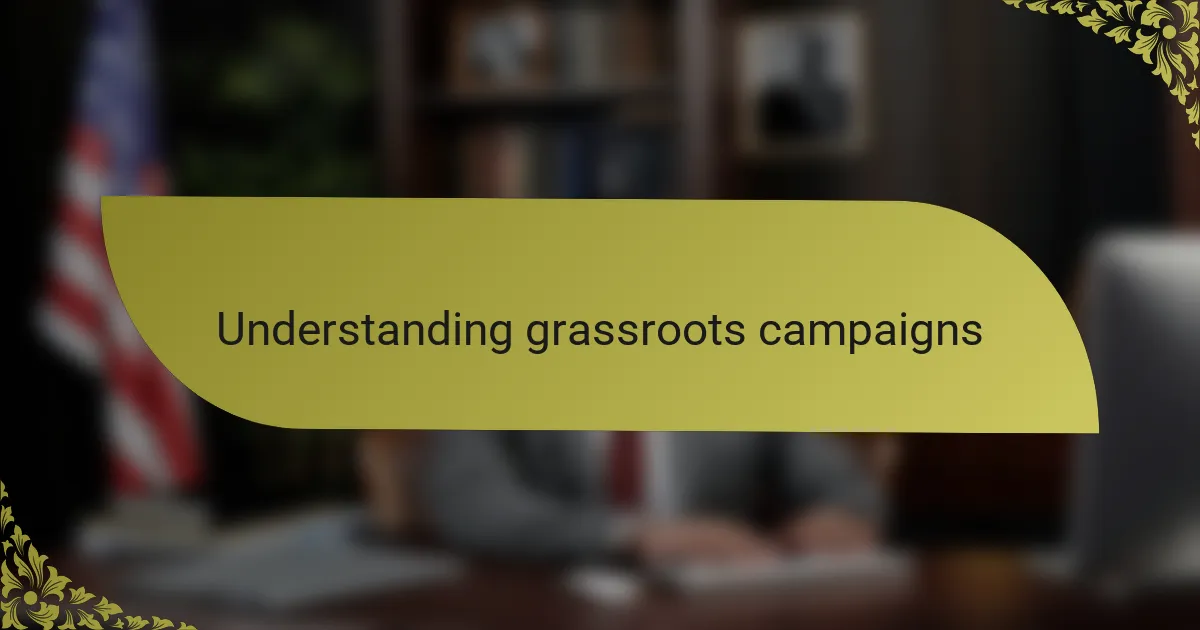
Understanding grassroots campaigns
Grassroots campaigns are all about building support from the ground up. They rely on the power of everyday people rather than big money or established political networks. I’ve witnessed how effective these campaigns can be; I’ve seen communities come together, fueled by shared concerns and a common goal, igniting a passion for change that resonates deeply within the group.
In my experience, grassroots movements often engage with their local communities more authentically than larger organizations. I remember participating in a town hall where everyone felt empowered to raise their voices and contribute. That sense of ownership is what makes these campaigns truly special and impactful.
Here’s a quick comparison table to illustrate key differences between grassroots campaigns and traditional campaigns:
| Grassroots Campaigns | Traditional Campaigns |
|---|---|
| Funded by small donations from individuals | Funded by large donations from corporations or wealthy individuals |
| Focus on local issues and community concerns | Focus on broader, often national issues |
| Relies on volunteers and community engagement | Utilizes paid staff and professional political consultants |
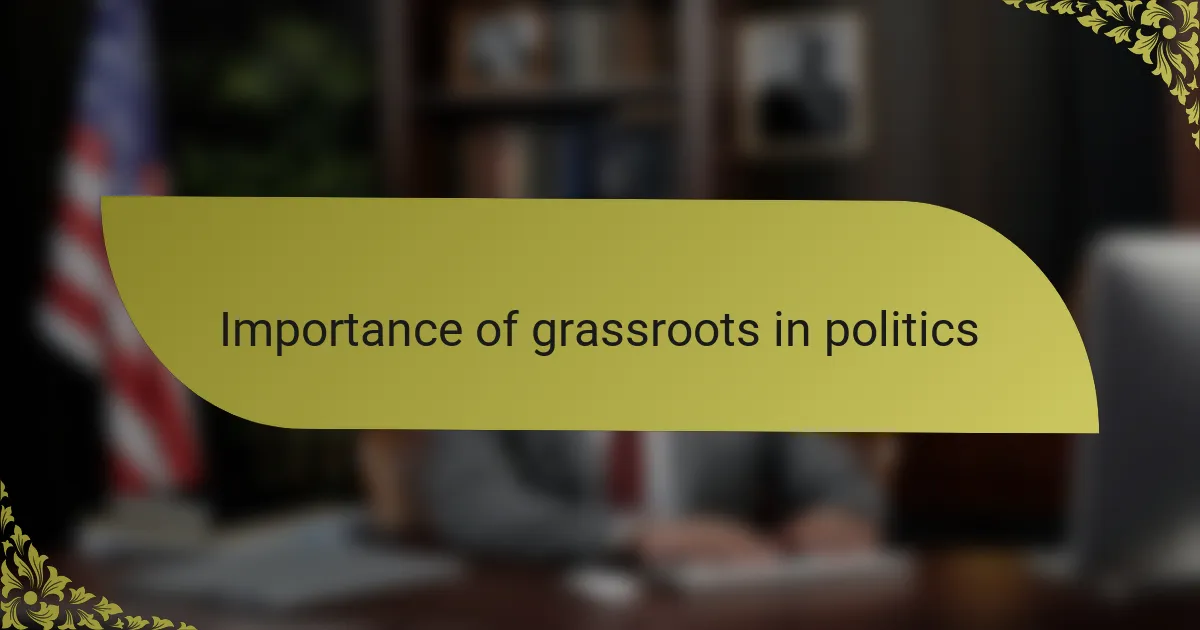
Importance of grassroots in politics
Grassroots campaigns play a crucial role in shaping the political landscape, particularly because they empower individuals to take an active role in governance. I’ve seen firsthand how a single concerned citizen can galvanize a community, creating a ripple effect that draws in others who share the same feelings but may have felt isolated in their concerns. When people unite around a cause, it fosters a sense of belonging and purpose that can be incredibly motivating.
The personal connections forged through grassroots efforts often lead to more authentic communication between leaders and constituents. I recall attending a local rally where the energy was palpable; every voice counted, and it reminded me of the power we all possess to make change. Such events spark conversations that might never occur in a traditional campaign setting, allowing for genuine dialogue about the needs and aspirations of the community.
Importantly, grassroots movements can shift the priorities of policymakers, as they are directly influenced by the voices of the people. Have you ever wondered why certain issues gain traction while others fade away? I believe it often boils down to the passionate advocacy of everyday citizens who refuse to be overlooked. This dynamic showcases how grassroots campaigns not only elevate local concerns but can also bring about significant changes in broader political discourse.
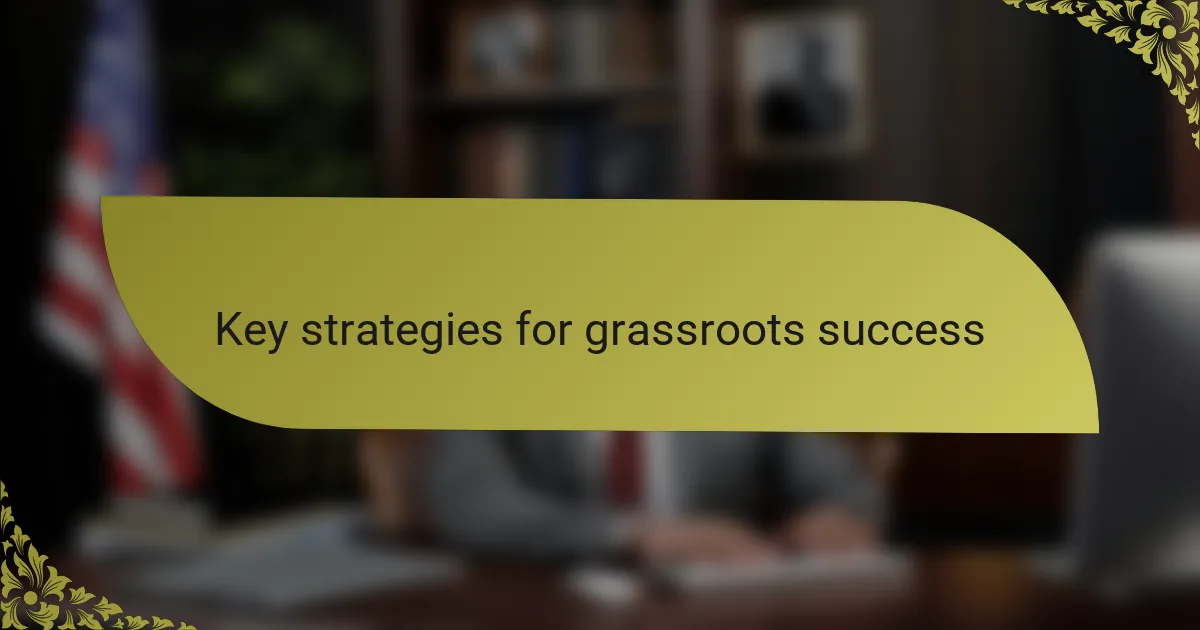
Key strategies for grassroots success
Key strategies for grassroots success hinge on building authentic connections and leveraging community strengths. From my experience, focusing on local issues that resonate deeply with residents creates a sense of ownership and urgency. For example, when advocating for improved public transportation in Louisiana, I saw how community meetings led to passionate discussions, turning passive supporters into active participants.
Additionally, utilizing social media effectively can amplify grassroots efforts. I remember launching a campaign on Facebook to gather support for a neighborhood cleanup initiative. The posts not only reached a wider audience but also inspired others to share their stories, creating a ripple effect that drew in volunteers and donations.
| Strategy | Description |
|---|---|
| Engagement | Foster meaningful connections with community members through meetings and events. |
| Social Media | Utilize platforms to spread awareness and gather support more efficiently. |
| Local Issues | Address concerns that resonate deeply with the community to inspire action. |
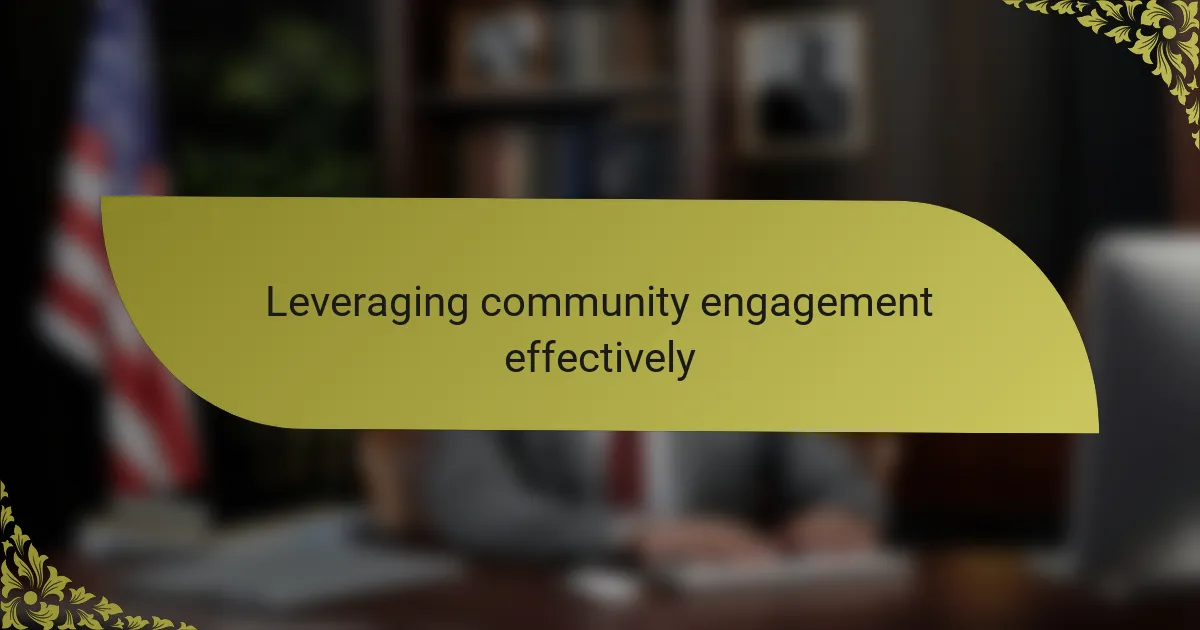
Leveraging community engagement effectively
Engaging the community effectively means cultivating genuine relationships that go beyond surface-level interactions. I remember canvassing my neighborhood and sharing not just my campaign messages but also my own reasons for getting involved. This approach led to heartwarming conversations and deep connections, reminding me how powerful it is to listen actively and empathize with people’s concerns. Have you ever really listened to your community? The stories I heard that day inspired me to be a better advocate.
Utilizing local events is another impactful way to foster engagement. I once hosted a potluck where community members brought their favorite dishes and we discussed upcoming initiatives. The atmosphere was relaxed, and people felt comfortable sharing their thoughts and ideas. This type of informal gathering breaks down barriers and encourages participation, making everyone feel like they have a stake in the conversation. It’s fascinating how food can unite us and spark meaningful dialogue.
Moreover, storytelling plays a crucial role in grassroots engagement. Sharing personal stories about how issues directly affect individuals can create emotional resonance that statistics often fail to achieve. For instance, when discussing healthcare reforms, I shared the story of a neighbor whose struggles inspired my commitment to the cause. It’s that emotional connection that moves hearts and minds, pushing community members to take action. Have you ever considered how your own story could ignite a passion for change in others? I truly believe that personal narratives can be the catalyst for a brighter future.
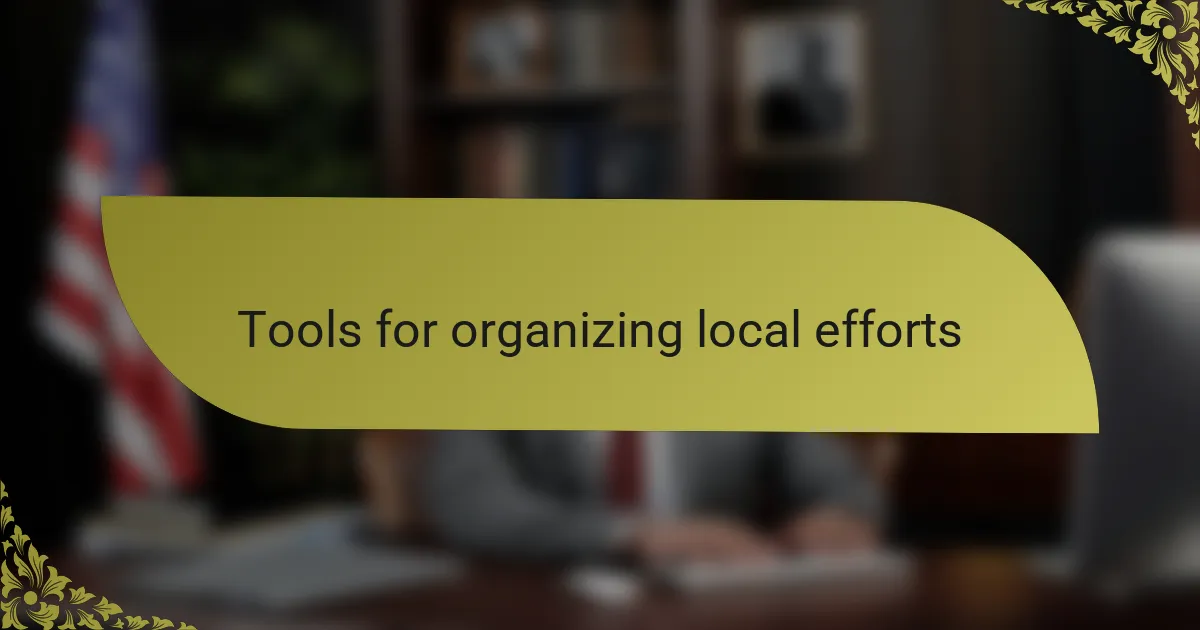
Tools for organizing local efforts
When I think about the tools for organizing local efforts, I immediately recall my experience using social media platforms. Tools like Facebook and Twitter were more than just communication channels for me; they became lifelines. I remember posting updates about our grassroots campaign and witnessing firsthand how quickly people rallied around our cause, sharing posts, and inviting friends.
Another invaluable resource was community organizing apps. For instance, I found platforms like Action Network pivotal in streamlining our outreach efforts. It allowed us to manage volunteer sign-ups and event notifications effortlessly. The ease with which I could mobilize supporters left me both amazed and encouraged, reinforcing the idea that technology can bridge gaps in activism.
Here are some essential tools for organizing local grassroots efforts:
- Social Media Platforms (Facebook, Twitter, Instagram)
- Community Organizing Apps (Action Network, Mobilize)
- Email Marketing Software (Mailchimp, Constant Contact)
- Project Management Tools (Trello, Asana)
- Messaging Apps (WhatsApp, GroupMe)
- Event Management Websites (Eventbrite, Meetup)
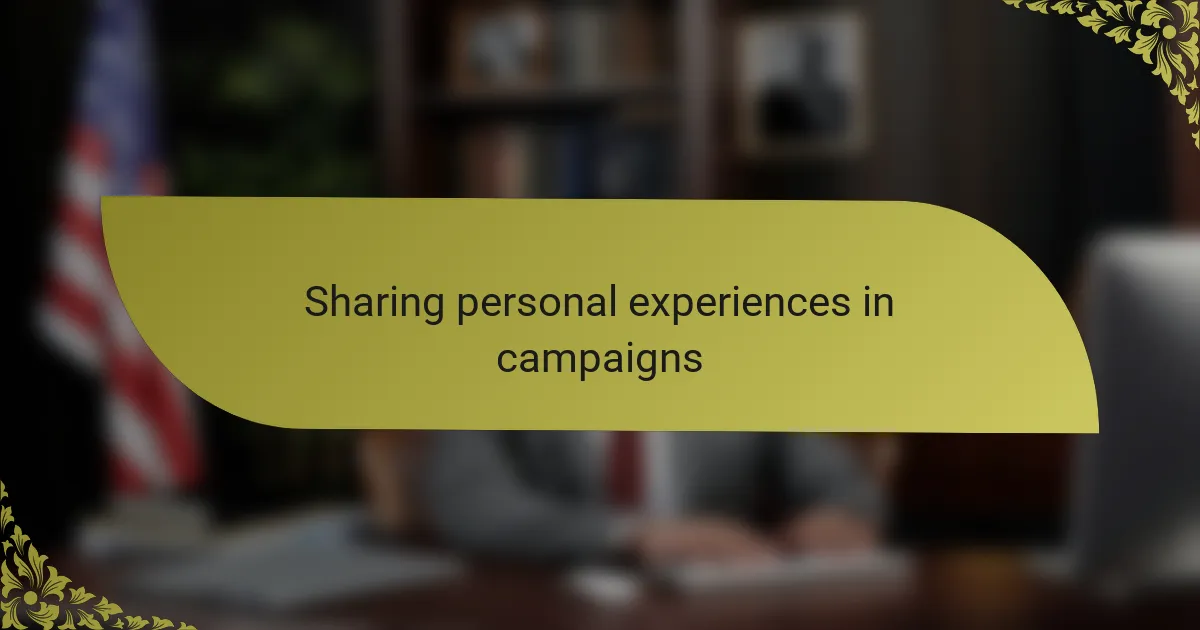
Sharing personal experiences in campaigns
Sharing personal experiences in campaigns has been one of the most enriching parts of my grassroots journey. I remember one specific event where I shared my story about the struggles of a local family facing housing insecurity. As I recounted their challenges to a small group, I could see the room’s atmosphere shift. Those anecdotes sparked a discussion that made many realize these weren’t just statistics on a page; they were real people in our community. Have you ever thought about how sharing your story could motivate others to take action?
During my time campaigning, I also discovered the immense power of vulnerability. At a gathering, I openly shared my own doubts and fears about making a difference. Surprisingly, my honesty resonated deeply with others. People began to open up about their own experiences, creating a space filled with empathy and understanding. It reminded me that it’s not just about the facts; it’s about connecting on a human level. How many times have you felt encouraged when someone was brave enough to show their true self?
Reflecting on these moments, I believe that storytelling is a fundamental aspect of any campaign. I’ve learned it’s not just about promoting ideas but about intertwining those ideas with our lives. For example, while advocating for environmental reforms, I spoke about my childhood memories spent in Louisiana’s wetlands. Those personal connections helped paint a vivid picture of what was at stake. When you share your journey, it stirs passion and prompts others to join you in your mission. How could your own experiences ignite a similar spark in your community?
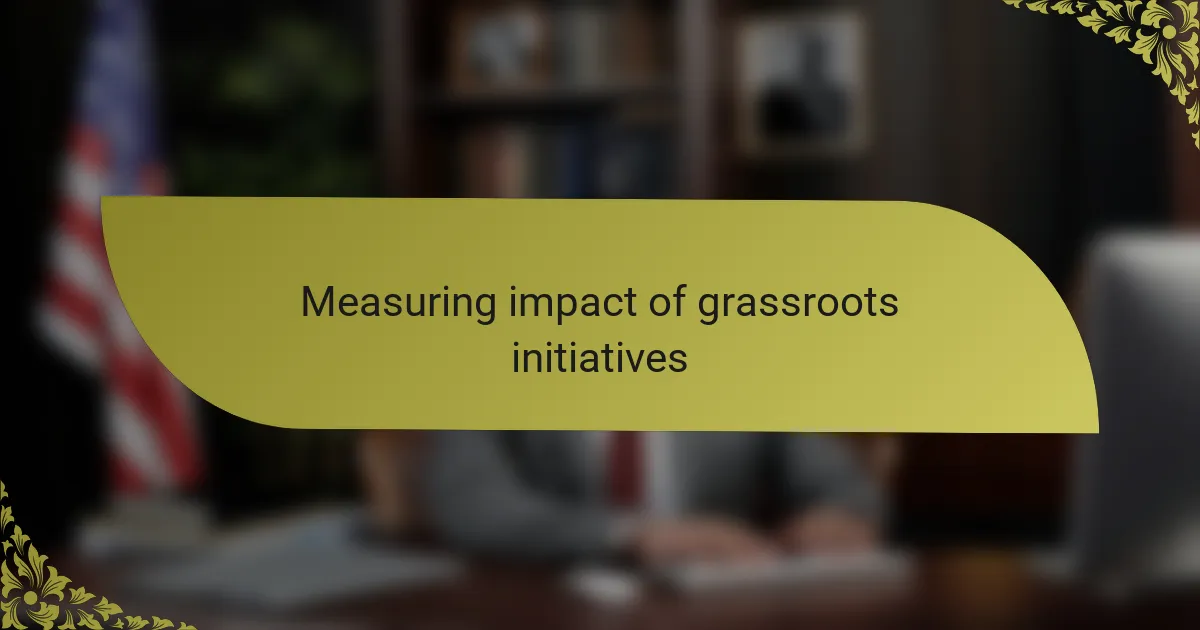
Measuring impact of grassroots initiatives
Measuring the impact of grassroots initiatives can be quite multifaceted, and I’ve found that gathering both qualitative and quantitative data is essential. For instance, after conducting a community survey on a neighborhood issue, I was surprised by how many residents participated. Their feedback not only helped shape our initiatives but also provided a clear measure of our campaign’s reach and effectiveness. Have you ever considered how a simple survey could illuminate your community’s thoughts?
One effective method I employed was tracking the attendance at events. I remember hosting a town hall meeting where we had a fantastic turnout. The energy in the room was contagious, and the number of attendees served as a direct indicator of growing interest and support. It was an eye-opener for me, showing that when community members feel their voices matter, they’re more likely to show up and engage. Isn’t it amazing how the numbers reflect the enthusiasm of the people?
Another insightful way to measure impact is through storytelling. I often gathered stories from community members who benefitted from our initiatives. One poignant narrative stood out: a single mother shared how our advocacy for improved local services changed her family’s day-to-day life. That personal testimony not only illustrated our campaign’s effectiveness but also served as a powerful motivator for volunteers. Sometimes, the true impact can be felt in the stories we share rather than just in the statistics we collect. How often do we overlook the power of personal stories in evaluating success?